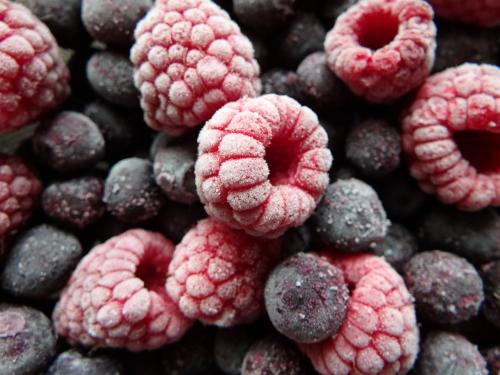Soft fruits considered in this study are Blackberries, Blueberries, Cherries, Grapes, Raspberries, and Strawberries.
The goal of the current study is:
(1) to explain the extent to which consumers’ purchases of soft fruit follow seasonal patterns;
(2) to estimate how Scotland’s seasonal patterns affect the purchase quantity/nutrient demanded, since this has significant implications for achieving the UK government's “five-a-day” policy target.
The study began with a graphical analysis to understand the evolution of soft fruit purchases in Scotland. All six types of soft fruits showed strong fluctuations (lows and highs) in purchases. However, raspberry and blueberries had both strong highs and lows and increased purchases over time. It is important to note that the periods of low and high purchases differed among the different soft fruits. For instance, the high demand for blackberries is in the summer whilst the low demands are usually in the winter. For blueberry, high demand periods are usually in the spring whilst low purchases are recorded in the winter seasons. Finally, the gap between low and high demand is very large in cherries and strawberries.
As regards the extent to which the average price of soft fruits differ between periods of high and low supply (purchases). In cherries, the average price gap is more than 200 per cent, which means that the highest price is more than twice the lowest price in a particular year. Strawberry and blueberry had average price gaps above 50 per cent. Whilst the remaining soft fruits had gaps below 50 per cent. Prices of grapes, which are mostly imported, were found to be the most stable, and this could encourage consumers to buy the fruit all year round.
Considering the wide price gaps during periods of low and high supplies, it is relevant to know the extent to which seasonality contribute to how retail retail prices for soft fruit are set for the six types of soft fruits. Our analysis shows that from 50 (for cherries) to 93 (strawberries) per cent of the variation in the prices of soft fruit set by retailers is explained by seasonal factors. Seasonality in soft fruit supply are usually independent of import volumes. For instance, a news item from DEFRA suggest that seasonality in vegetable prices is due to bad weather conditions in the UK (Maurice-Jones, 2023). This translates into a high cost for a nutritious diet during periods of low supply. The US’s FRED Economic Data confirms that the abundance of strawberries during the summer pushes prices to their annual lows. Whilst this is good for low-income consumers and overall diet quality, the instability in prices is likely to destabilize diet quality during low supply.
Regarding how households with earnings less than £30,000 a year (i.e., lowest income in the sample) react to prices during the four seasons in a year. For blueberry, cherries, raspberry and strawberry, consumers sensitivity to prices increases from Autumn and fall in the Summer period. This is evident for both their expenditure and own-price elasticities. Cherries and strawberries had the biggest variations in consumers sensitivity to prices which is measured by their average price elasticities. For cherries and strawberries, consumers are most responsive to price changes in the spring (low supply) but least sensitive in the Autumn (high supply). The fluctuation in the sensitivity of consumers to prices could be explained by harvest times (period of boom) and period before harvest (period of scarcity). For instance, cherries are harvested from June to August leading to an abundance during the Summer and Autumn and hence the lower sensitivity by consumers to prices. Also, strawberries are picked from June to October which could explain the lower own price elasticity during the Summer and Autumn periods.
The implication of the results is that it exposes the inaccuracies in food demand studies that ignore the sensitivity of consumers to prices during the different seasons in a year. Therefore, using annual average sensitivity estimates to inform policy regarding seasonal demand can be flawed. Consumers reaction to soft fruit prices vary significantly depending on the season of the year. Accounting for variations in consumers reaction to price, especially for perishable foods, is important for both policy accuracy and to understand consumer behaviour. A strategy to maintain the same price all year round would help to stabilise consumers’ diet.
In terms of diet quality and nutrient intake, purchases of soft fruits are higher when prices are low (when consumers are less sensitive to price changes). At higher prices, demand is low, and the nutritional benefits derived from soft fruit are masked. A study by Capita & Alonso-Calleja, (2005) confirms that total average daily intake of fruit and vegetable consumption was found to vary significantly by the season of the year.
By Dr Wisdom Dogbe at the Rowett Institute and Professor Cesar Revoredo Giha at Scotland’s Rural College (SRUC).
References:
Capita, R., & Alonso-Calleja, C. (2005). Differences in reported winter and summer dietary intakes in young adults in Spain. International Journal of Food Sciences and Nutrition, 56(6), 431–443. https://doi.org/10.1080/09637480500407875
Maurice-Jones, A. (2023, July 19). Fresh produce sector weathers ‘tough periods.’ The Morning Advertiser. https://www.morningadvertiser.co.uk/Article/2023/07/19/why-have-wholesale-fruit-and-veg-prices-gone-up
Image:
Dr Michelle Wilson-Chalmers.
